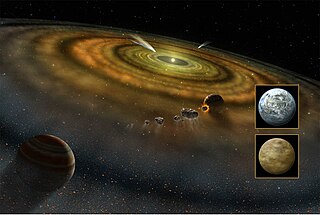Related Research Articles

Hot Jupiters are a class of gas giant exoplanets that are inferred to be physically similar to Jupiter but that have very short orbital periods. The close proximity to their stars and high surface-atmosphere temperatures resulted in their informal name "hot Jupiters".

An eccentric Jupiter is a Jovian planet that orbits its star in an eccentric orbit. Eccentric Jupiters may disqualify a planetary system from having Earth-like planets in it, because a massive gas giant with an eccentric orbit may eject all Earth mass exoplanets from the habitable zone, if not from the system entirely.

An exomoon or extrasolar moon is a natural satellite that orbits an exoplanet or other non-stellar extrasolar body.

HD 189733 b is an exoplanet in the constellation of Vulpecula approximately 64.5 light-years away from our Solar System. Astronomers in France discovered the planet orbiting the star HD 189733 on October 5, 2005, by observing its transit across the star's face. With a mass 11.2% higher than that of Jupiter and a radius 11.4% greater, HD 189733 b orbits its host star once every 2.2 days at an orbital speed of 152.0 kilometers per second, making it a hot Jupiter with poor prospects for extraterrestrial life.

The habitability of natural satellites describes the study of a moon's potential to provide habitats for life, though is not an indicator that it harbors it. Natural satellites are expected to outnumber planets by a large margin and the study is therefore important to astrobiology and the search for extraterrestrial life. There are, nevertheless, significant environmental variables specific to moons.
HD 65216 b is an extrasolar planet located approximately 115 light-years away in the constellation of Carina, orbiting the star HD 65216. This planet was discovered by the Geneva Extrasolar Planet Search Team in 2003. Like most planet candidates so far, it was detected with the radial velocity method.
HD 89744 b is an eccentric Jupiter extrasolar planet orbiting the star HD 89744.

An exocomet, or extrasolar comet, is a comet outside the Solar System, which includes rogue comets and comets that orbit stars other than the Sun. The first exocomets were detected in 1987 around Beta Pictoris, a very young A-type main-sequence star. There are now a total of 27 stars around which exocomets have been observed or suspected.

PH2, also known as Kepler-86, or KIC 12735740, is a G-type star 1,120 light-years distant within the constellation Cygnus. Roughly the size and temperature of the Sun, PH2 gained prominence when it was known to be the host of one of 42 planet candidates detected by the Planet Hunters citizen science project in its second data release. The candidate orbiting around PH2, known as PH2b, had been determined to have a spurious detection probability of only 0.08%, thus effectively confirming its existence as a planet.

V1400 Centauri is a pre-main-sequence star in the constellation Centaurus at a distance of about 451 light-years from Earth. A relatively young star, its age is estimated to be 16 million years, and its mass is about 90% that of the Sun. The star has a maximum apparent magnitude of 12.2 and requires a telescope to be seen. The star's name comes from the SuperWASP program and the star's coordinates.

Tabby's Star is an F-type main-sequence star in the constellation Cygnus approximately 1,470 light-years from Earth. A distant red dwarf companion has been reported, making Tabby's Star a binary stellar system.

Tabetha "Tabby" Suzanne Boyajian is an American astronomer of Armenian descent and astrophysicist on faculty at Louisiana State University. She was a post-doctoral fellow 2012–16 at Yale University, working with Debra Fischer. Boyajian is active in the astronomical fields of stellar interferometry, stellar spectroscopy, exoplanet research, and high angular resolution astronomy, all particularly at optical and infrared wavelengths. She was the lead author of the September 2015 paper "Where's the Flux?", which investigated the highly unusual light curve of KIC 8462852; the star is colloquially known as Tabby's Star in her honor.

TRAPPIST-1 is a cool red dwarf star with seven known exoplanets. It lies in the constellation Aquarius about 40.66 light-years away from Earth, and has a surface temperature of about 2,566 kelvins. Its radius is slightly larger than Jupiter and it has a mass of about 9% of the Sun. It is estimated to be 7.6 billion years old, making it older than the Solar System. The discovery of the star was first published in 2000.

In astronomy, a disrupted planet is a planet or exoplanet or, perhaps on a somewhat smaller scale, a planetary-mass object, planetesimal, moon, exomoon or asteroid that has been disrupted or destroyed by a nearby or passing astronomical body or object such as a star. Necroplanetology is the related study of such a process.

EPIC 204376071 is an M-type star in the constellation of Scorpius. Parallax measurements by the Gaia space observatory put the star at a distance of about 440 light-years from Earth. It is likely a member of the Upper Sco association, and is young enough that it has not yet become a main-sequence star.

The Neptunian desert or sub-Jovian desert is broadly defined as the region close to a star (period < 2–4 days) where no Neptune-sized ( > 0.1 MJ) exoplanets are found. This zone receives strong irradiation from the star, meaning the planets cannot retain their gaseous atmospheres: They evaporate, leaving just a rocky core.
Kepler-1708b is a Jupiter-sized exoplanet orbiting the Sun-like star Kepler-1708, located in the constellation of Cygnus approximately 5,600 light years away from Earth. It was first detected in 2011 by NASA's Kepler mission using the transit method, but was not identified as a candidate planet until 2019. In 2021, a candidate Neptune-sized exomoon in orbit around Kepler-1708b was found by astronomer David Kipping and colleagues in an analysis using Kepler transit data.
References
- ↑ Metzger, Brian D.; Stone, Nicholas C.; Martinez, Miguel (20 June 2019). "Orphaned Exomoons: Tidal Detachment and Evaporation Following an Exoplanet-Star Collision". Monthly Notices of the Royal Astronomical Society. 489 (4): 5119. arXiv: 1906.08788 . Bibcode:2019MNRAS.489.5119M. doi:10.1093/mnras/stz2464. S2CID 195316956.
- 1 2 3 Starr, Michelle (10 July 2019). "Scientists Are Trying to Make 'Ploonets' a Thing, And We Are Here For It". ScienceAlert. Retrieved 12 July 2019.
- ↑ Sucerquia, Mario; Alvarado-Montes, Jaime A.; Zuluaga, Jorge I.; Cuello, Nicolas; Giuppone, Cristian (27 June 2019). "Ploonets: formation, evolution, and detectability of tidally detached exomoons". Monthly Notices of the Royal Astronomical Society. 489 (2): 2313. arXiv: 1906.11400 . Bibcode:2019MNRAS.489.2313S. doi:10.1093/mnras/stz2110. S2CID 195700030.
- ↑ Grossman, David (10 July 2019). "They're Not Moons. They're Not Planets. They're Ploonets". Popular Mechanics . Retrieved 12 July 2019.
- ↑ Starr, Michelle (18 September 2019). "There's a New Explanation For Mysterious Tabby's Star: A Melting Ploonet". ScienceAlert. Retrieved 19 September 2019.
- ↑ Astronomy Magazine, "Ploonets: When a planet's moon goes rogue", Jake Parks, 15 July 2019
- ↑ How Stuff Works Magazine, "Ploonets: When Moons Become Planets", Patrick J. Kiger, 23 July 2019
- ↑ Sucerquia, Mario; Alvarado-Montes, Jaime A.; Zuluaga, Jorge I.; Cuello, Nicolas; Giuppone, Cristian (27 June 2019). "Ploonets: formation, evolution, and detectability of tidally detached exomoons". Monthly Notices of the Royal Astronomical Society. 489 (2): 2313–2322. arXiv: 1906.11400 . Bibcode:2019MNRAS.489.2313S. doi:10.1093/mnras/stz2110. S2CID 195700030.
- ↑ Whyte, Chelsea (4 July 2019). "Exomoons that run away from their planets could become 'ploonets'". New Scientist . Retrieved 12 July 2019.
- ↑ Strickland, Ashley (17 July 2019). "Wandering moons called 'ploonets' could be the culprits behind astronomical mysteries". CNN News . Retrieved 17 July 2019.
- ↑ Kooser, Amanda (10 July 2019). "Ploonets, hell yeah. Runaway moons get a charmingly goofy name". CNET . Retrieved 12 July 2019.
